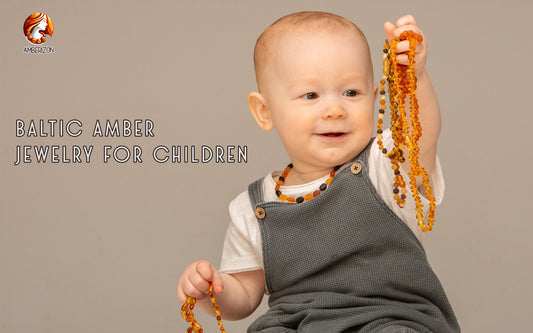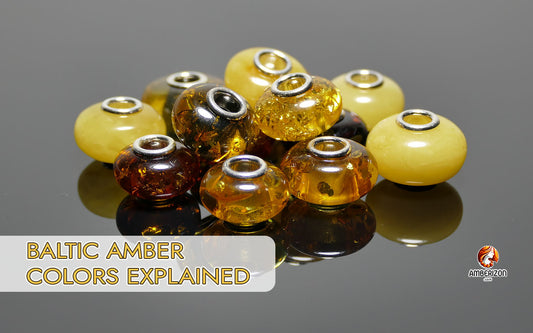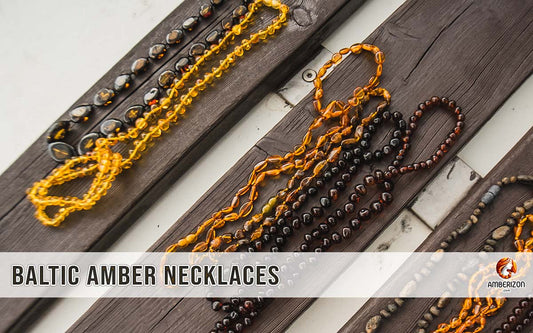
How to Say 'Amber' in Different Languages
What Amber is Called in Other Languages


English: Amber
In English, the word "amber" comes from the Arabic word “anbar,” originally referring to ambergris, a waxy substance found in the intestines of sperm whales. Over time, the term shifted to refer to fossilized tree resin, which we know as amber today. The word carries connotations of warmth, light, and the golden-brown hue that makes amber so distinct.
Spanish: Ámbar
In Spanish-speaking countries, amber is called “ámbar.” This term closely mirrors the English "amber," with a similar etymological root from the Arabic “anbar.” Ámbar is highly prized in Latin America, especially in countries like Mexico and the Dominican Republic, where unique varieties of amber are found.
French: Ambre
In French, amber is known as “ambre.” The word is pronounced with the typical soft French "r" sound, giving it a subtle and elegant flair. Amber has long been a popular material in French jewelry and decorative arts, celebrated for its warm tones and organic beauty.
German: Bernstein
In German, amber is called “Bernstein,” which translates literally to “burning stone.” This name comes from the fact that amber can burn and produce a pleasant pine-like scent when lit. The Germans were among the earliest traders of amber, particularly from the Baltic Sea, and the term Bernstein reflects the gem’s fiery essence.
Italian: Ambra
In Italian, amber is referred to as “ambra.” Like its French and Spanish counterparts, ambra originates from the Arabic root “anbar.” Italy has a long history of working with amber, especially in crafting fine jewelry, and the word ambra evokes the luxurious and ancient nature of the gemstone.
Russian: Янтарь (Yantar)
In Russian, amber is known as “янтарь” (yantar). This word comes from the Lithuanian and Old Prussian term for amber, reflecting the close connection between Russia and the Baltic region, one of the world’s richest sources of amber. Yantar is highly valued in Russia, where it has been used in everything from art to jewelry to medicine.
Polish: Bursztyn
In Polish, amber is called “bursztyn.” The word is derived from the German “Bernstein” and has a deep historical significance in Poland, where amber has been mined and traded for centuries. The Baltic coast, shared by Poland, is one of the richest sources of amber in the world, making bursztyn a central part of Polish culture and history.
Lithuanian: Gintaras
In Lithuanian, amber is referred to as “gintaras.” Amber plays a significant role in Lithuanian folklore and tradition, where it is considered a protective stone with magical qualities. Gintaras is deeply ingrained in the culture, and amber jewelry is a common symbol of national pride.
Latvian: Dzintars
In Latvian, amber is called “dzintars.” Amber holds an important place in Latvian culture and history, particularly due to the country's location along the Baltic Sea, where amber deposits are plentiful. Dzintars is also a common male given name in Latvia, signifying the cultural reverence for the gemstone and its association with strength, protection, and tradition.
Greek: Ηλεκτρον (Elektron)
In ancient Greek, amber was called “ἤλεκτρον” (elektron). This name is the origin of the modern word "electricity," as amber, when rubbed, can produce static electricity. The Greeks were fascinated by amber’s ability to attract small objects when charged, and its name reflects this mysterious property.
Turkish: Kehribar
In Turkish, amber is known as “kehribar.” The word reflects the long history of amber trading through Turkey, a crossroads between Europe and Asia. Amber is commonly used in Turkish prayer beads, known as "tesbih," where its smooth texture and warm glow make it a popular material.
Arabic: عنبر (Anbar)
In Arabic, amber is called “عنبر” (anbar), a word that historically referred to both amber and ambergris. Amber has been valued in the Arab world for centuries, often used in perfumes, jewelry, and as a healing substance in traditional medicine.
Chinese: 琥珀 (Hǔpò)
In Chinese, amber is called “琥珀” (hǔpò). The characters represent the image of a "tiger’s soul" (hǔ) and "spirit" (pò), symbolizing amber’s powerful and mystical qualities. Amber has been used in Chinese medicine and art for thousands of years, and its name reflects its spiritual and protective properties.
Hindi: अंबर (Ambar)
In Hindi, amber is referred to as “अंबर” (ambar), a word borrowed from Persian. While amber is not as prominent in South Asia as it is in Europe, it still holds cultural significance, particularly for its use in traditional healing practices and decorative objects.
Japanese: 琥珀 (Kohaku)
In Japanese, amber is called “琥珀” (kohaku). The word is similar to the Chinese hǔpò and also carries connotations of tiger-like strength and beauty. Amber has been used in Japanese art and jewelry for centuries, often symbolizing warmth, clarity, and longevity.
Finnish: Meripihka
In Finnish, amber is known as “meripihka,” which literally means "sea resin." This name reflects the amber that is often found washed up along the Baltic coastline. Finland’s proximity to the Baltic Sea makes amber, or meripihka, a valued material in the region’s craft and tradition.
Amber's Names in Baltic Region Languages:
 |
Lithuanian - GintarasGintaras (Amber) is a Lithuanian masculine given name. Name Gintaras is of Lithuanian origin. People with name Gintaras are usually Christians (Catholics) by religion. |
 |
Latvian - DzintarsDzintars (Amber) is a Latvian masculine given name borne by more than 4,000 men in Latvia. The name means "amber". Its nameday is celebrated on 4th September. |
 |
Estonian - MerevaikIn Estonian, "amber" is referred to as "Merevaik" because it translates to "sea resin." This term likely originates from the historical understanding that amber often washes ashore from the sea, suggesting its connection to the water or the sea. |
 |
Polish - BursztynThe term "bursztyn" in Polish refers to amber. It's derived from the Old Polish word "borzęstein" or "bursztynek," which were used historically to describe amber. Over time, the word evolved into "bursztyn," which is the modern Polish term for amber. |
 |
Russian - Yantar (янтарь)In Russian, the word for amber is "янтарь" (pronounced as "yantar"). This term has been used for centuries in the Russian language to refer to the fossilized resin gemstone known as amber. |
 |
German - BernsteinIn German, "amber" is translated as "Bernstein" because it is derived from the words "bär," meaning "burn" or "fire," and "stein," meaning "stone." This likely refers to the ancient practice of burning amber for its aromatic properties, as well as its fiery appearance when held up to the light. |
 |
Finnish – MeripihkaIn Finnish, "amber" is referred to as "Meripihka." This term likely stems from the words "meri," meaning "sea," and "pihka," meaning "resin." Therefore, "Meripihka" essentially translates to "sea resin" or "resin from the sea." This name reflects the origins of Baltic amber, which often washes ashore along the Baltic Sea coastlines. |
 |
Swedish – BärnstenThe word "Bärnsten" is derived from Old Norse and is used in Swedish to refer to amber. It translates to "burning stone," which likely reflects the traditional belief that amber could produce a scent similar to resin when heated. |
 |
Norwegian – Rav"Rav" is the Norwegian word for amber. It derives from the Old Norse word "rauðr," meaning "red," which likely refers to the color of some amber varieties. Over time, "rauðr" evolved into "rav" in Norwegian. |
 |
Danish – RavThe word "amber" in Danish is "rav" because it has historical roots in the Old Norse language. The term "rav" has been used for centuries in the Scandinavian region to refer to amber, likely stemming from the Old Norse word "rauðr," meaning "red" or "reddish-brown," which describes the color of many types of Baltic amber. Over time, this term evolved into "rav" in Danish, and it continues to be the common word for amber in the Danish language today. |
 |
Icelandic – Raf |
English language:
The English name for amber is derived from the Arabic word anbar, originally used to describe ambergris (Eng. ambra).
![]()
American English: amber
![]()
Brazilian Portuguese: âmbar
- Chinese: 琥珀
- Croatian: jantar
- Czech: jantar
- European Spanish: ámbar
- French: ambre
- Greek: κεχριμπάρι
- Italian: ambra
- Japanese: 琥珀色
- Korean: 호박(광물)
- European Portuguese: âmbar
- Romanian: chihlimbarambră
- Thai: อำพัน
- Turkish: kehribar
- Ukrainian: бурштин
- Vietnamese: hổ phách
Amber is a universal gem, treasured across continents and cultures for its beauty, history, and unique properties. Each language provides a glimpse into how this fossilized resin is perceived and appreciated by different peoples. Whether it's “amber” in English, “yantar” in Russian, or “kohaku” in Japanese, the name of amber carries with it stories of nature, warmth, and tradition.







